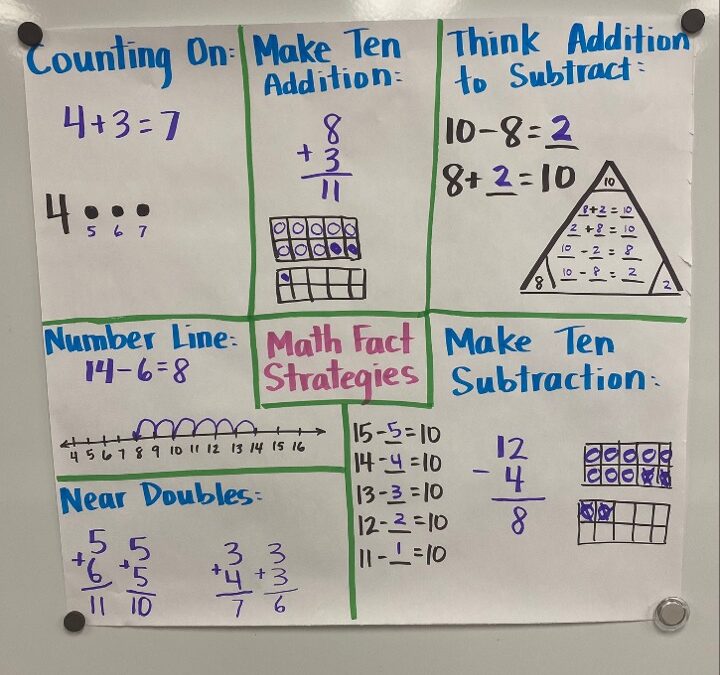If young students struggle with fact fluency, then it’s likely it will affect the rest of their math abilities. Math facts are the foundation for higher level math. That is why I like to teach my 2nd grade students math fact fluency strategies. These are so helpful to students because if they ever forget a fact in the moment, they have tools they can choose from on how to get the answer. If my students know fact fluency strategies, they are set up for success with higher level math.
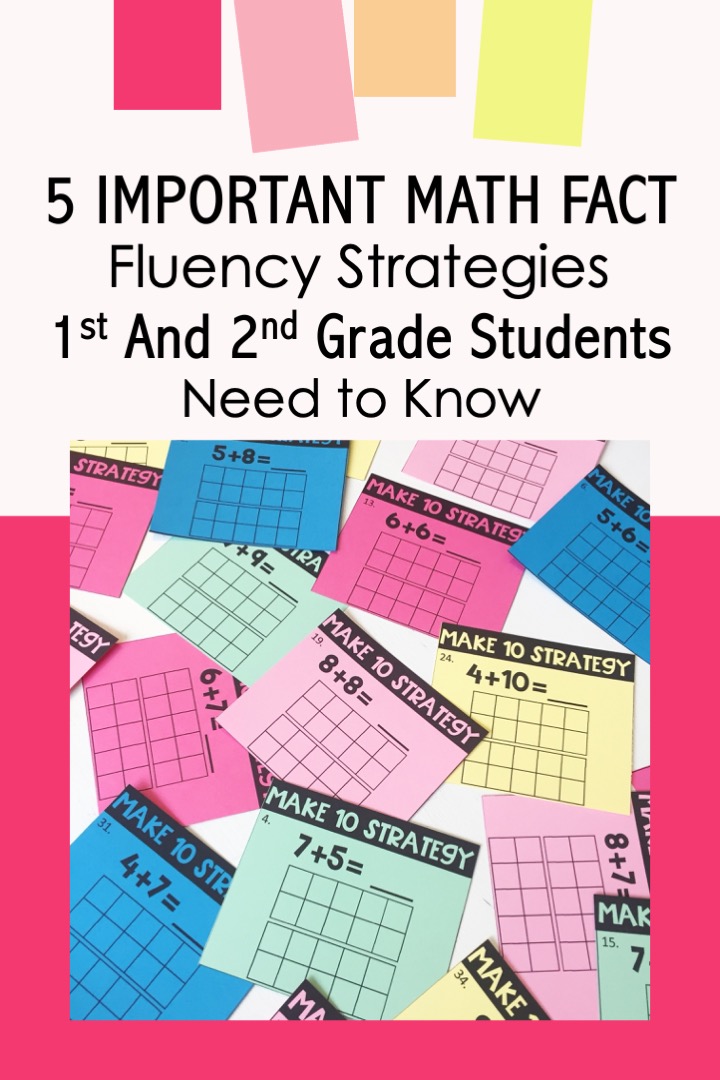
These 5 math fact fluency strategies are so important for students to master.
So today I thought I would share what math fact fluency strategies are and how I teach them in my classroom. Because the more you teach these fact fluency strategies, the more connections students make with the numbers and facts, making it more likely that they will commit the facts to memory.
If you’re a parent who has a child struggling with math, you’ve got to check out Learner. Learner is an online tutoring platform that sets students up for success. To get started take a short quiz about your child’s needs. Then Learner’s Success Management Team reviews that and matches your child with the perfect tutor. Get your $25 trial here.
Okay so let’s first get into why fact fluency is important.
Why is Fact Fluency Important
Here’s just a few reasons on how I have seen why fact fluency is important:
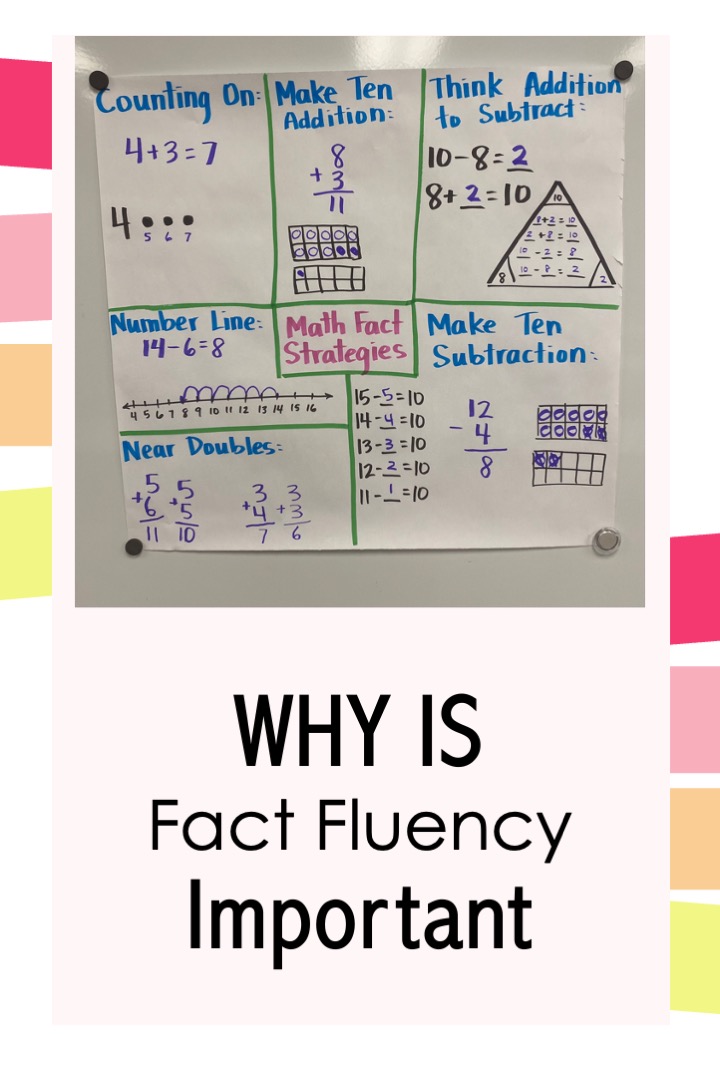
Why is fact fluency important? There are so many reasons! A solid foundation in fact fluency help students be successful with higher level math.
Efficiency in calculations: Fact fluency allows students to solve addition and subtraction problems quickly and accurately. This is called automaticity. Automaticity with basic math facts saves students valuable time during mathematical tasks and assessments.
Mental math abilities: When students have fact fluency, they can perform calculations mentally, without relying heavily on manipulatives or written methods. This enhances their number sense and overall mathematical thinking.
Strong foundation for higher-level math: Fact fluency serves as a solid foundation for more complex mathematical concepts and operations that students will encounter later on in the school year, and later in other grades. It enables them to focus on higher-order thinking rather than struggling with basic arithmetic. Fact fluency empowers them to analyze problems, make connections, and apply mathematical reasoning effectively. Developing fact fluency in 1st and 2nd grade prepares students for the increasing complexity of math concepts in higher grades. It sets them on a path for success in multiplication, division, fractions, and other advanced mathematical topics.
Confidence in math: A lack of fact fluency can lead to frustration and insecurity in math. On the other hand, when students are confident in their ability to recall math facts quickly, they approach math tasks with more confidence and enthusiasm.
Mental flexibility: Developing fact fluency requires students to understand and apply various strategies for solving addition and subtraction problems. This enhances their mental flexibility, allowing them to approach math problems from different angles.
Fact fluency is essential for 1st and 2nd grade students as it builds a strong mathematical foundation, enhances problem-solving skills, boosts confidence, and prepares them for future math concepts and real-world applications.
But what is the best way to get students to be fluent with their addition and subtraction math facts?
In the past, I thought I had to be drilling my students with flash cards and timed tests. But I realized this was creating a lot of math anxiety in my students. And for my students who struggled, it didn’t help them learn their math facts. They just continued to struggle. If they came to a fact they didn’t know, they would shut down mentally and emotionally because they didn’t have the tools to figure out a math fact in the moment. Rote memorization also didn’t help them develop math flexibility and number sense. When they got to a pressured situation where they needed to know that fact quickly, students forgot what they had memorized and couldn’t reason through the numbers to come up with the answer.
That is why I started teaching math fact fluency strategies and focusing on them with my students.
Math fact fluency strategies help students find an answer to math facts even if they forgot what they memorized. These strategies focus on number sense and patterns. Fact fluency strategies are less stressful on students than rote memorization. They are also more hands-on and engaging for students. These strategies to improve math fact fluency help students discover the answer for themselves, making it more likely for them to commit the facts to memory. Overall, math fact fluency strategies help students understand the math facts they are committing to memory.
So let’s take a look at the math fact fluency strategies I teach to my students.
Math Fact Fluency Strategies
Here are the addition and subtraction math strategies that I teach my 2nd grade students, but are also good for 1st grade:
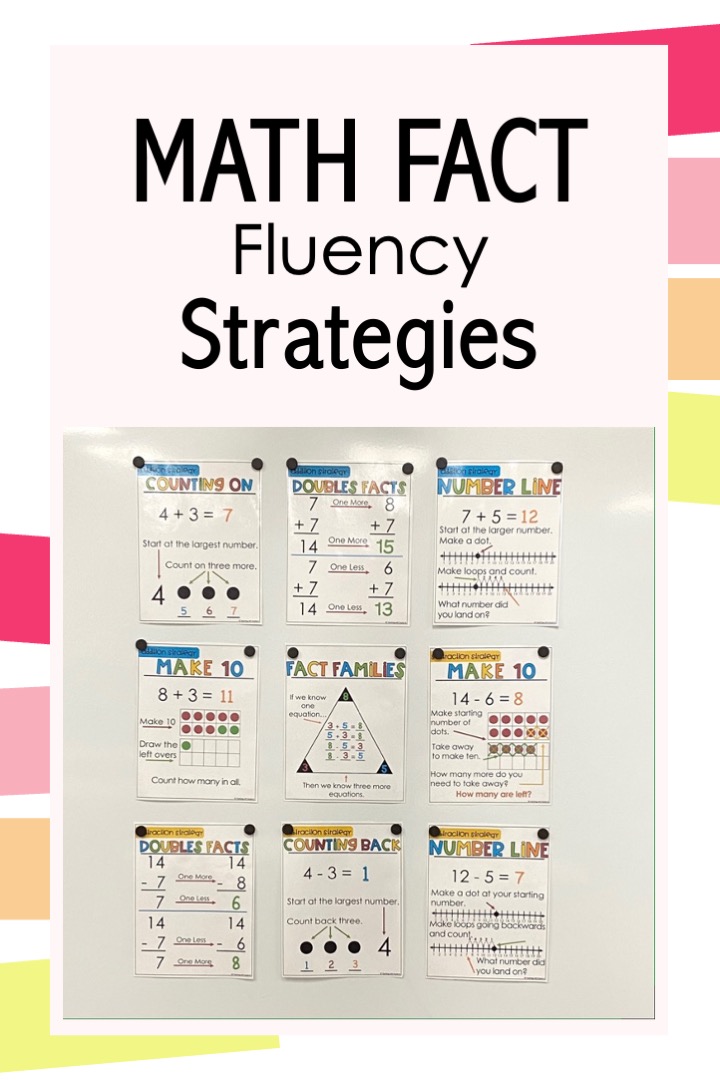
These are the fact fluency strategies I like to teach my 2nd grade students.
Counting on: This strategy involves starting with a number and then counting on to find the answer. For example, to solve 3 + 4, a student would start with 3 and count on four more numbers: 4, 5, 6, 7. The answer is 7. I have my students “punch” the bigger number and count on with their fingers. This helps them keep the numbers straight as they are counting on.
Counting back: Similar to counting on, this strategy involves starting with a number and counting backwards to find the answer to a subtraction problem. For example, to solve 9 – 3, a student would start with 9 and count back 3 spaces: 8, 7, 6. The answer is 6.
Using a number line: A number line can be a helpful tool for students to visualize addition and subtraction problems. For example, to solve 7 – 2, a student could start at 7 and count back two spaces on the number line to find the answer, which is 5. I display a large number line above our front whiteboard so my students can use it when needed.
Making ten: This strategy involves using the fact that 10 is an easy number to work with to simplify addition and subtraction problems. We work with and have seen the number ten a lot, since we have 10 fingers. Making the number 10 easier to work with for students. Here’s how this strategy works: to solve 8 + 7, a student could recognize that 8 + 2 = 10 and then add 5 more, which is 15. To solve 9 – 6, a student could recognize that 6 + 4 = 10 and then subtract 4 more, which is 3.
Doubles and near doubles: Our brains love novelty. That is why it is easier for students to remember doubles facts. Students can use the knowledge of doubles (e.g. 2 + 2 = 4, 3 + 3 = 6) to quickly solve related addition and subtraction problems. For example, to solve 3 + 4, a student could recognize that 4 is one more than 3 and therefore use the fact that 3 + 3 = 6 to quickly find the answer, which is 7.
For a one page reference sheet for all of these math fact fluency strategies, download my free workbook for 1st and 2nd grade teachers here: The 7 Steps to Ensure Math Fact Fluency
When teaching math fact fluency strategies, it is important to keep in mind the stages of math fact mastery. It is developmentally appropriate to first teach your students counting strategies. These strategies include counting on, counting back, and using a number line.
When students show proficiency in these, then they will find better success with reasoning strategies such as the make ten strategy and near doubles strategy. Learn more about the stages of math fact fluency here in this blog post: The 3 Stages of Math Fact Mastery
When my students start to share their reasoning on how they got to an answer to a math fact, it makes my teacher heart so happy. I can see them applying the math fact fluency strategies I have taught them. I see them then commit those facts to memory and then are able to automatically know them.
This doesn’t come all at once. Don’t just think you will teach the strategy once and students will be applying it all the time. This comes by explicitly teaching each strategy, modeling using those strategies often, and getting students lots of practice with those strategies. Here’s how I do this in my classroom so that students can apply these strategies in various contexts to support their understanding and proficiency.
Strategies to Improve Math Fact Fluency
Here is how I teach my students these math fact fluency strategies. I’ve seen it work best when I explicitly teach each strategy, model using the strategies often, and then give students lots of practice.
Explicitly Teach Each Strategy: When I am first teaching a math fact strategy to students, I like to use an anchor chart to help guide me as I’m teaching and to show students the steps. It also makes things more visual for students and they can reference the anchor chart anytime needed.
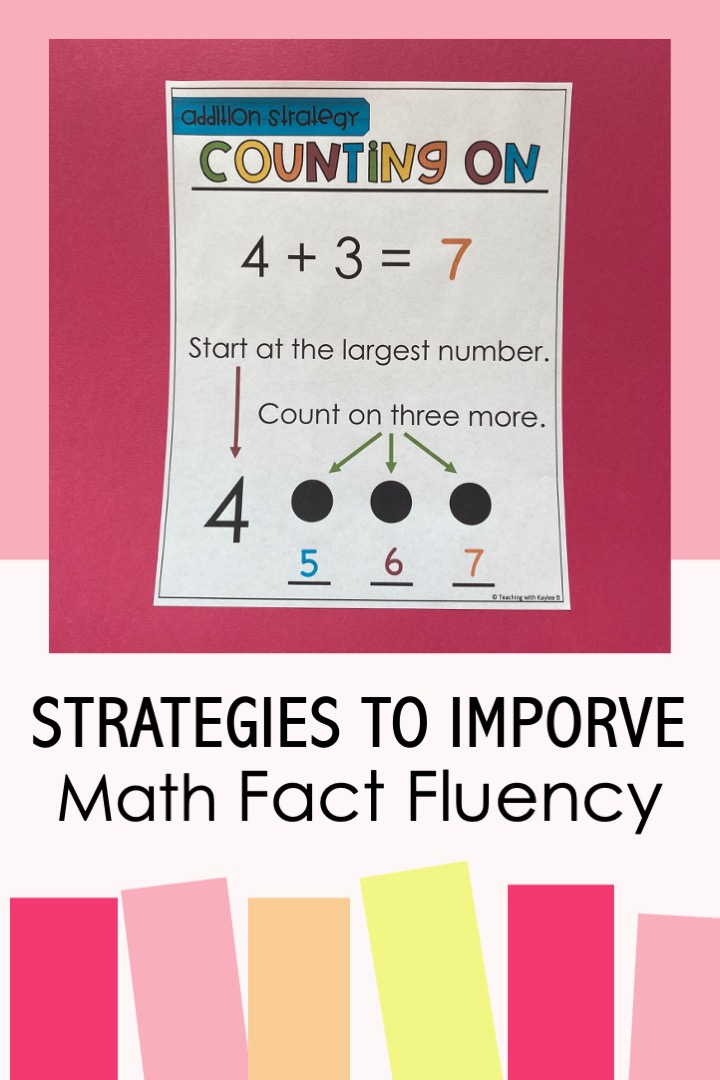
One of my favorite strategies to improve math fact fluency is the counting on strategy.
Let me show you how I would do this with the counting on strategy:
Show Students the Slow Way. Right an equation like 5+3= _ on the board. Count out 5 fingers on one hand. Then count 3 fingers on the other hand. Then count them all together. Emphasize that this way takes too much time. We can take some short cuts!
Show Students To Group the First Number and Start There. Instead of counting out the 5. We can just start at 5. That’s the first short cut! I like to “punch” 5 so I remember to start there. So here’s my 5. Now I need to count on 3 more. 5…6,7,8. The answer is 8! Was that way faster than the first? Yes!
Show Students To Start At the Larger Number. What if the equation was 3+5. I could start at 3 and count on 5. (Show students that) Or I can start at the larger number. Which one is greater? 3 or 5? 5! So I’m going to punch 5 and count on 3. Have students do it with you this time. Punch 5 and count on…6,7,8. Our answer is still the same even though we started at the larger number! And we saved time!
Show Students We Don’t Have to Punch Every Time. Even though counting on is faster than counting out both the numbers. It still takes some time. If we come across the equation 5+3 = _ do we need to count on? Or do we already know the answer. Yes, the answer is 8! We have already been working on it so we know it! Do we need to take the time to count on if we already know it? No. What about the equation 3+5 = _? We already know that one too! As we count on with an equation so many times, we will begin to remember the answer and we won’t need to take the time to count on anymore!
Find the anchor charts I use to teach each math fact fluency strategy here.
Model Using Strategies Often: Now that you have explicitly taught the strategy, you want to continue to model it throughout the school year. Whenever we come to a math fact in our regular lesson, I will ask a student to choose a strategy we could use to find the answer. This is why I like to display the anchor charts. Students can easily remember all the strategies and pick one to use. Then I will “think aloud” as I solve the math fact. Once students get the hang of seeing me do this, I will call on students to model solving the math fact.
I also do this daily with our Math Fact of the Day routine. During our morning math meeting and calendar time, I post up a math fact. When I am first teaching this routine, I “think aloud” to students so they can see me choosing a math fact fluency strategy and using it. After a few days of students seeing me do this, I let them try. I give them some time to think to themselves and find the math fact answer. Then they will turn and talk to a neighbor and share how they got to the answer.
I love how this shows that there are lots of good ways to solve math facts. Then I will call on a few students to share their reasoning. As they are talking, I am taking notes on the board of what they are doing with the numbers to get to the answer. Learn more about this routine here in this blog post: How to Consistently Do Math Problem a Day in Lower Elementary Grades
When you model strategies to your students, they will be more likely to use them. The more they use them, the more likely they are to make connections with the facts and commit the facts to memory, making students fluent with math facts. But you want to give students quality math fact fluency activities to do this.
Give Students Lots of Practice: There are two kinds of math fact fluency activities: strategy practice and fluency practice.
After you explicitly teach a strategy, you want to give students guided practice and independent practice with that strategy. For guided practice, I like to have my students do task cards with a partner. I tape the task cards up around the classroom. Students have a recording page and they go around the classroom solving the problems on the task cards. These task cards help guide students to use the strategy taught. As students solve the problems, I am walking around giving any needed support.
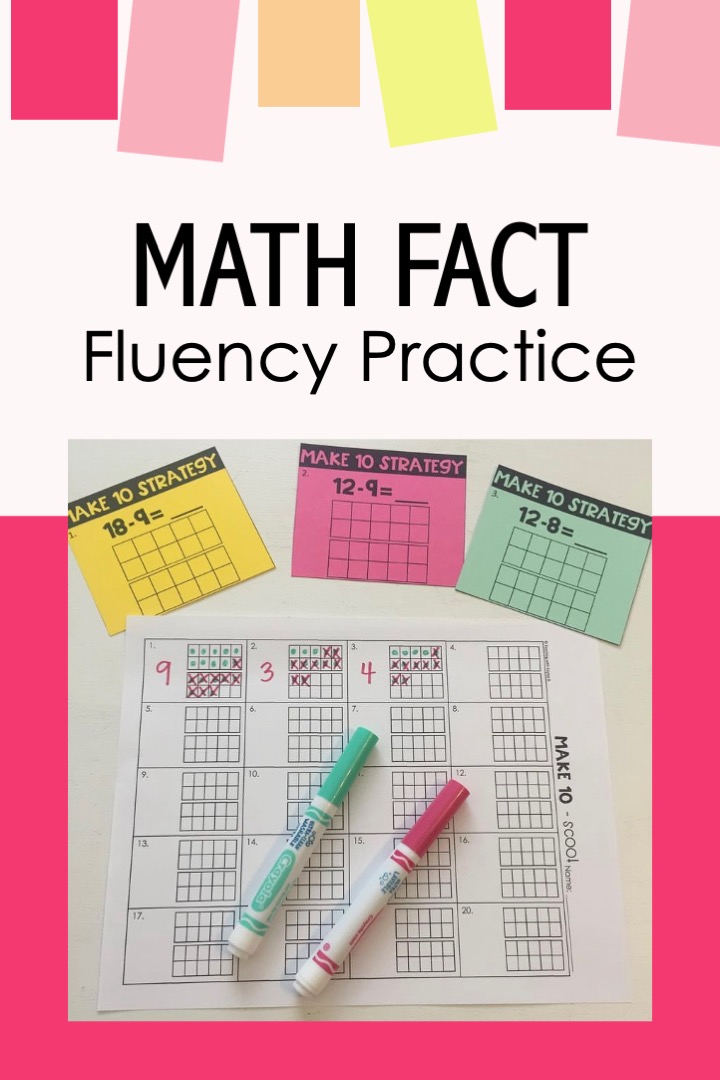
Students love these task cards as math fact fluency activities.
After they have practiced with a partner, I have them complete a strategy worksheet. This helps me see who needs more instruction with the strategy. Find these task cards and worksheets for each strategy in this money saving bundle here.
For fluency practice I like to keep things fun and engaging for my students. I set our math fact games for center activities or fast finisher activities. These games have plain math facts where they don’t guide students on strategies. Students will naturally use strategies to solve the math facts and play the games. Find the games that I have my students play in this bundle here.
When students are taught math fact fluency strategies, have those strategies modeled to them often, and get plenty of quality practice that is where the magic happens. Students actually use those strategies. And because of that, they are able to commit the facts to memory or are able to get to the answer in 5 seconds or less. That is where they get all the benefits of math fact fluency I mentioned before. They will grow in confidence, have a strong foundation for higher-leveled math, and have increased math flexibility and number sense.
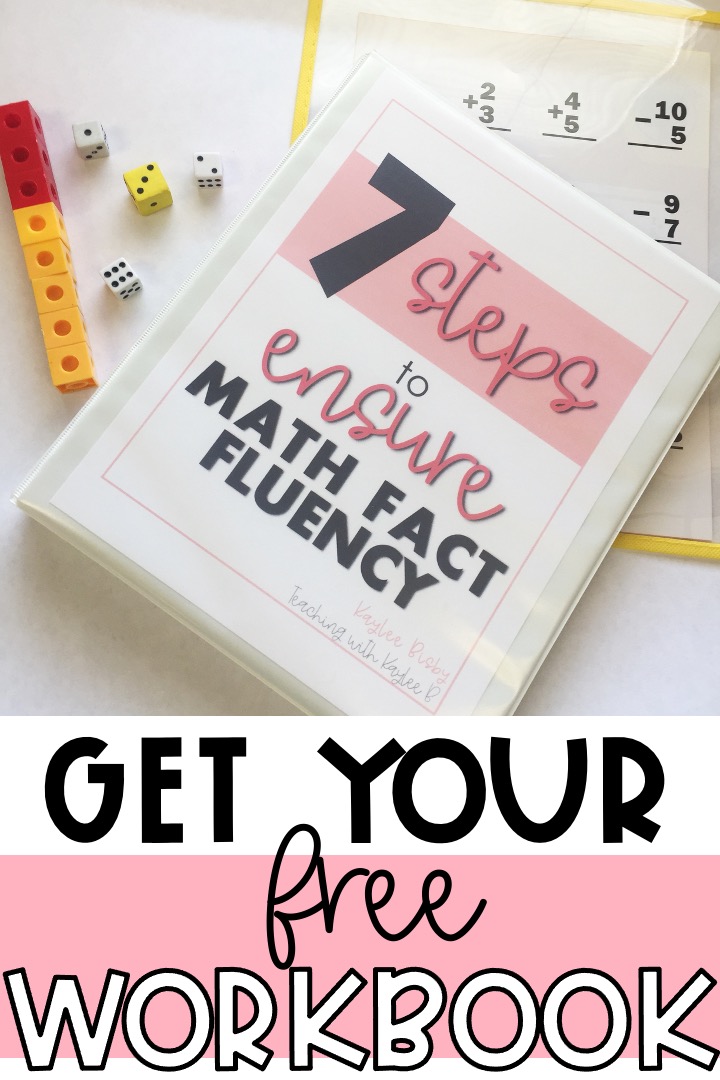
For more tips on getting your students to math fact fluency, download my free workbook for 1st and 2nd grade teachers: The 7 Steps to Ensure Math Fact Fluency

